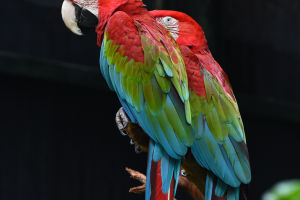Hummingbirds are the smallest birds in the world, measuring about the size of a bee. Although they are small, their eyes are large and focused, and they have gorgeous feathers. Some species have a long tail that flutters in the wind.
Hummingbirds have a thin and long beak, like a tube, which allows them to reach into flowers to suck nectar. They make a "humming" sound like a bee when they fly to collect honey, which is why they are called hummingbirds. The smallest hummingbirds are only 6 cm long and weigh about 2 grams.
Hummingbirds are a large family with approximately 320 species. The bee hummingbird, found in Cuba, is the smallest species, weighing less than 2 grams and measuring only 5 cm long. The largest species is the giant hummingbird, weighing up to 20 grams.
Hummingbirds are known for their beautiful iridescent feathers, which reflect light in different ways depending on the angle of the sun. However, they are most famous for their unique flying abilities. Despite their small size, hummingbirds can fly very fast, with a top speed of 50 kilometers per hour.
The mouth and tail of a hummingbird account for half of its body length. Despite their small size, every hummingbird is a master of flight. They can flap their wings 20 to 200 times per second and can fly horizontally, creating a generally constant buoyancy force against their body.
Hummingbirds rely primarily on vision since they do not have a well-developed olfactory system. They are sensitive to UV light at 325-360 nanometers, making finding flowers with a UV spectrum easier.
The plumage color of male birds can be used by females and competitors of the same species to assess leadership, and status, and distinguish species.
Although birds have long been considered the least intelligent animals, new research shows that hummingbirds have extraordinary brains to control their hovering, flying in any direction, and descending extremely fast.
The pectoral muscles are the power source for hummingbirds' various tricks, accounting for 30% of their body weight, which exceeds the ratio of any other bird species (the pectoral muscles of most birds account for 15-18% of their body weight). These muscles act like motors, generating a steady stream of power to make the wings "vibrate at high frequencies."
Hummingbirds have a fast metabolism, and any food they eat is digested quickly to keep them energized during the day. They eat about half their body weight in food to stay active! If hummingbirds slept like most other animals, they would starve.
To survive the night, hummingbirds switch to a deep sleep called torpor. This slows down the rate at which their entire body expends energy.
During torpor, the hummingbirds' heart rate drops from 1,000 beats per minute to less than 100, and their core temperature drops from 40°C to 18°C. While this allows them to make it through the night, they still lose up to 10% of their body weight in the process.
In conclusion, hummingbirds are fascinating creatures with extraordinary abilities. Their small size, unique flying abilities, and beautiful feathers make them a wonder to behold.
Although they have been traditionally considered unintelligent, new research shows that they have remarkable brains to control their movements. Hummingbirds are a true marvel of nature, and we can learn much from studying these tiny birds.


